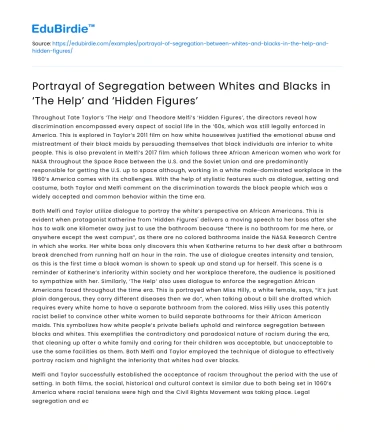Throughout Tate Taylor’s ‘The Help’ and Theodore Melfi’s ‘Hidden Figures’, the directors reveal how discrimination encompassed every aspect of social life in the ‘60s, which was still legally enforced in America. This is explored in Taylor’s 2011 film on how white housewives justified the emotional abuse and mistreatment of their black maids by persuading themselves that black individuals are inferior to white people. This is also prevalent in Melfi’s 2017 film which follows three African American women who work for NASA throughout the Space Race between the U.S. and the Soviet Union and are predominantly responsible for getting the U.S. up to space although, working in a white male-dominated workplace in the 1960’s America comes with its challenges. With the help of stylistic features such as dialogue, setting and costume, both Taylor and Melfi comment on the discrimination towards the black people which was a widely accepted and common behavior within the time era.
Both Melfi and Taylor utilize dialogue to portray the white’s perspective on African Americans. This is evident when protagonist Katherine from ‘Hidden Figures' delivers a moving speech to her boss after she has to walk one kilometer away just to use the bathroom because “there is no bathroom for me here, or anywhere except the west campus”, as there are no colored bathrooms inside the NASA Research Centre in which she works. Her white boss only discovers this when Katherine returns to her desk after a bathroom break drenched from running half an hour in the rain. The use of dialogue creates intensity and tension, as this is the first time a black woman is shown to speak up and stand up for herself. This scene is a reminder of Katherine’s inferiority within society and her workplace therefore, the audience is positioned to sympathize with her. Similarly, ‘The Help’ also uses dialogue to enforce the segregation African Americans faced throughout the time era. This is portrayed when Miss Hilly, a white female, says, “it’s just plain dangerous, they carry different diseases then we do”, when talking about a bill she drafted which requires every white home to have a separate bathroom from the colored. Miss Hilly uses this patently racist belief to convince other white women to build separate bathrooms for their African American maids. This symbolizes how white people’s private beliefs uphold and reinforce segregation between blacks and whites. This exemplifies the contradictory and paradoxical nature of racism during the era, that cleaning up after a white family and caring for their children was acceptable, but unacceptable to use the same facilities as them. Both Melfi and Taylor employed the technique of dialogue to effectively portray racism and highlight the inferiority that whites had over blacks.
Save your time!
We can take care of your essay
- Proper editing and formatting
- Free revision, title page, and bibliography
- Flexible prices and money-back guarantee
Melfi and Taylor successfully established the acceptance of racism throughout the period with the use of setting. In both films, the social, historical and cultural context is similar due to both being set in 1060’s America where racial tensions were high and the Civil Rights Movement was taking place. Legal segregation and economic inequalities limited African American women’s employment opportunities which are apparent in ‘The Help’ where all the black women are labored as domestic servants in white homes. The audience further understands how America ignored the racism which bound black women to low paying jobs. In contrast, the women in ‘Hidden Figures’ are shown to overcome racial segregation in the work place and become employed at NASA during the space race although, the women are still viewed as inferior to men. This gives the audience a better understanding of the extent of the society at the time and the inequality which occurred during the civil rights movement. Consequently, both films portray the idea that it was acceptable to be racist due to the rules of society.
The costumes utilized in both films effectively portrays the segregation between whites and blacks. In ‘The Help’, the African American maid’s uniforms were simple grey cotton whilst the white women’s costumers were bold floral prints. Taylors use of costumes worked to give the audience insight into the ‘60s fashion and the significant difference between black and white females is depicted. It essentially makes white females appear more beautiful and appealing then black people. Conversely, ‘Hidden Figures’ portrays the black women to wear bright eye-catching colored outfits with bold print details. Whilst the white men and women dress solely in grey and white outfits. Bright colors consistently single out the black characters from the white ones therefore, the audience’s attention is directed to the black individuals. It is portrayed that the black community is vibrant and full of life from their colorful outfits. The effect of these bright costumes elevates the black females working at NASA, giving them the heroic status which the film emphasizes upon these women. In essence, the costumes set the ‘hero’ apart from everyone else. Both Taylor and Melfi employed the technique of costumes to effectively appeal to the segregation between whites and blacks.
Throughout ‘The Help’ and ‘Hidden Figures’, Tate Taylor and Theodore Melfi explore the injustices of segregation between whites and African Americans. The two films share many stylistic similarities such as dialogue, setting and costume to portray the excessive amount of discrimination present in the 1960’s America. The two films convey through dialogue the white’s perspective on African Americans and the inferiority the whites had. Furthermore, the idea that racism was acceptable and normal is explored through setting. In addition, the costumes in both films portray the segregation between whites and blacks although, this is done differently in each film. Both Tate Taylor and Theodore Melfi use stylistic techniques to explore the discrimination present, which conveys a specific purpose: to help the viewer understand the treatment towards African American people particularly women, demonstrating the importance of equality.






 Stuck on your essay?
Stuck on your essay?

